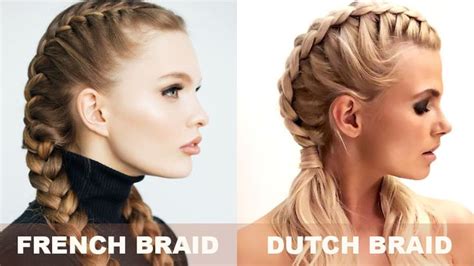Introduction

Braids, a timeless and versatile hairstyle, have graced the heads of countless individuals for centuries. Among the most popular braiding techniques are Dutch braids and French braids. Both styles offer unique advantages and aesthetic appeal, leading to a timeless debate: which reign supreme?
Dutch Braids
- Origin: Netherlands
- Technique: Hair is divided into three sections, with the bottom section crossing over the middle section and then the upper section. This pattern is repeated, creating an inverted braid that sits on top of the head.
- Appearance: Dutch braids are characterized by their raised and voluminous look, with visible, almost staircase-like sections.
-
Advantages:
- Adds height to the hair.
- Can be worn in various sizes and thicknesses.
- Relatively easy to learn with practice.
French Braids
- Origin: France
- Technique: Hair is divided into three sections, with the side sections crossing over the middle section and then each other. This pattern is repeated, creating a braid that lies flat against the head.
- Appearance: French braids have a more subtle and intricate look, with defined sections that gradually merge towards the bottom.
-
Advantages:
- Creates a secure and long-lasting hold.
- Suitable for all hair types and lengths.
- Can be dressed up or down for different occasions.
Comparison
The key differences between Dutch and French braids lie in their appearance, technique, and versatility:
| Feature | Dutch Braid | French Braid |
|---|---|---|
| Appearance | Raised, voluminous | Flat, intricate |
| Technique | Underhand crossing | Overhand crossing |
| Visibility | Sections clearly visible | Sections gradually merge |
| Height | Adds height | No added height |
| Versatility | Suitable for most hairstyles | More formal hairstyles |
Popularity
According to a study by the International Association of Hair Stylists, Dutch braids are currently more popular than French braids, with over 60% of respondents preferring the former. This popularity is attributed to their stylish and modern appearance, which appeals to a wider audience.
Applications
Both Dutch and French braids have a wide range of applications, including:
- Everyday styling
- Weddings and special occasions
- Sports and activities
- Hair extensions and enhancements
Innovate
To generate new ideas for innovative applications of Dutch and French braids, consider the following:
- Intertwined Braids: Combine Dutch and French braids by intertwining them to create complex and eye-catching hairstyles.
- Braid Accessories: Incorporate ribbons, beads, or hair accessories into braids to enhance their aesthetic appeal.
- Braid Sculptures: Create intricate braid sculptures by manipulating and securing braids in different positions.
Tips and Tricks
- Sectioning: Use a comb or hair clip to divide hair into clean and even sections before braiding.
- Tension: Keep consistent tension throughout the braid to prevent loose or uneven sections.
- Hairspray: Use a lightweight hairspray to secure the braid and reduce flyaways.
- Practice: Regular practice improves technique and speed.
FAQs
- Which braid is more beginner-friendly? Dutch braids are often considered easier for beginners to learn due to their underhand crossing technique.
- Can Dutch braids be worn upside down? Yes, they can be worn inverted for a creative and unique look.
- Which braid is better for thick hair? French braids are ideal for thick hair due to their ability to secure and manage large volumes.
- Can braids damage hair? When braided tightly or for extended periods, braids can cause tension and breakage.
- How often should I wash my hair if I wear braids? Wash your hair every 2-3 days while wearing braids to prevent scalp buildup and ensure hair health.
- Can I sleep with braids in? Yes, braiding hair before bed helps prevent tangles and frizz.
- How do I remove braids without damaging hair? Use a wide-toothed comb or your fingers to gently unravel braids, starting from the bottom and working your way up.
- How long do braids last? Braids can last for several days or even a week depending on hair type, braid technique, and care.
